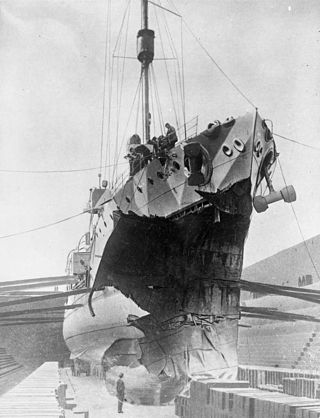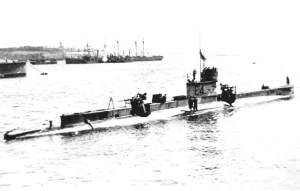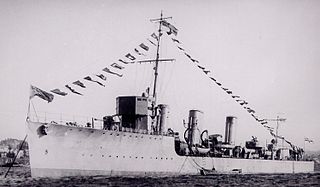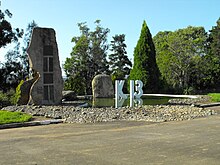
The K-class submarines were a class of steam-propelled submarines of the Royal Navy designed in 1913. Intended as large, fast vessels with the endurance and speed to operate with the battle fleet, they gained notoriety and the nickname of "Kalamity class" for being involved in many accidents. Of the 18 built, none were lost through enemy action, but six sank, with significant loss of life, in accidents. Only one ever engaged an enemy vessel, K-7 hitting a U-boat amidships, though the torpedo failed to explode with what has been described as typical "K" luck; K-7 escaped retaliation by steaming away at speed.

The Battle of May Island is the name given to the series of accidents that occurred during Operation E.C.1 in 1918. Named after the Isle of May, a nearby island in the Firth of Forth, the "battle" consisted of a disastrous series of accidents amongst Royal Navy vessels on their way from Rosyth, Scotland, to fleet exercises in the North Sea. On the misty night of 31 January–1 February 1918, five collisions occurred between eight vessels. Two K-class submarines were lost and four other submarines and a light cruiser were damaged. 105 British sailors in total died in the accidents.

HMS Ithuriel was a Marksman-class flotilla leader of the British Royal Navy. Originally to have been named Gabriel, the name was changed before her launch. The ship was built by Cammell Laird at Birkenhead, being launched on 8 March 1916 and entering service in August that year. Ithuriel served with the Grand Fleet during the First World War, leading both a destroyer flotilla and a submarine flotilla. She survived the war, before being sold for scrap on 8 November 1921.

HMS K5 was one of the K-class submarines that served in the Royal Navy from 1917–1921. She was lost with all hands when she sank en route to a mock battle in the Bay of Biscay.
HMS K14 was a K class submarine built by Fairfields in Govan, Scotland. She was laid down in November 1915, and commissioned on 22 May 1917.
HMS D3 was a D-class submarine of the British Royal Navy, one of eight of this class. D3 was built by Vickers at their Barrow-in-Furness works in 1910–1911, being launched on 17 October 1910 and completed on 30 August 1911.

HMS E4 was a British E class submarine built by Vickers, Barrow-in-Furness, costing £101,900. E4 was laid down on 16 May 1911, launched on 5 February 1912 and commissioned on 28 January 1913. On 24 September 1915 E4 was attacked by the German airship SL3. On 15 August 1916, she collided with sister ship E41 during exercises off Harwich. Both ships sank and there were only 14 survivors, all from E41. Both boats were raised, repaired and recommissioned. She was sold on 21 February 1922 to the Upnor Ship Breaking Company.

HMS E55 was a British E-class submarine built by William Denny, Dumbarton as Yard No.1032. She was launched on 5 February 1916 and was delivered on 25 March 1916. E55 was sold for scrap at Newcastle on 6 September 1922.
HMS E54 was a British E-class submarine built by William Beardmore, Dalmuir. She was laid down on 1 February 1915 and was commissioned in May 1916. She sank the German submarines UC-10 on 21 August 1916 and U-81 on 1 May 1917. E54 was sold for scrap on 14 December 1921.
HMS K17 was a British K class submarine built by Vickers in Barrow-in-Furness.

HMS Rapid was a destroyer of the M class that served with the Royal Navy during First World War. Launched by Thornycroft in 1916, the vessel was the one of two similar ships ordered as part of the Fifth War Construction Programme. They differed from the remainder of the M class in having more powerful engines. The design was used as the basis for the subsequent five ships of the R-class also built by the yard. Rapid served in escort and patrol roles, principally providing defence from submarines as part of the Grand Fleet until it was disbanded at the end of the War. After the end of hostilities, the vessel served in minor roles, including briefly as part of the Admiralty Compass Department in 1921 and 1924, but was sold to be scrapped in 1927.

HMS Radstock was the first in a class of 62 R-class destroyers. The design differed from the preceding M-class primarily in the use of geared turbines, which gave better fuel efficiency. The ship was launched in 1916 and served with the Grand Fleet of the Royal Navy during World War I as in an escort and anti-submarine role. While escorting a convoy in 1918, the destroyer collided with the merchant ship Volute, but otherwise had an uneventful war. After the Armistice of 11 November 1918 that ended the war, the vessel was recommissioned with reduced complement and joined the Reserve Fleet. Radstock stayed in Reserve until 1927. By this time, the vessel had deteriorated and, despite having a refit in 1925, was deemed unfit for service and was sold to be broken up.

HMS Raider was the second of a class of sixty two R-class destroyers operated by the Royal Navy. Launched in 1916, the vessel served with the Grand Fleet during World War I. The destroyer was built as part of the preceding M-class but was equipped with geared turbines which improved efficiency and increased range. The ship was involved in anti-submarine patrols, but did not sink any German submarines. After the war, the destroyer initially moved to Harwich and was briefly stationed in Ireland after the Irish Civil War. In 1923, the Navy decided to retire the older destroyers in the fleet and, although initially spared, Raider was decommissioned and sold to be broken up in 1927.

HMS Narwhal was a Admiralty M-class destroyer which served with the Royal Navy during the First World War. The M class were an improvement on the preceding L class, capable of higher speed. Launched on 30 December 1915, the vessel fought in the Battle of Jutland between 31 May and 1 June 1916 and subsequently served in anti-submarine and escort duties based at Cobh in Ireland. During February 1917, the destroyer rescued the crew of the Q-ship Farnborough, which had sunk and been sunk by the German submarine SM U-83, and rescued the armed merchantman Cameronia from SM U-50, The destroyer was transferred to Devonport during 1918 and, after the end of the war, was broken up there in 1920 after suffering a fatal collision the year before.

HMS Mounsey was a Yarrow M-class destroyer of the British Royal Navy. Built by the Scottish shipbuilder Yarrow in 1914–1915, Mounsey served in the Grand Fleet during the First World War, and took part in the Battle of Jutland. The following year she saw combat against German submarines, and in 1918 she helped rescue crew and passengers aboard the damaged troopship Otranto. She was sold for scrap in 1921.

HMS Parthian was a Admiralty M-class destroyer which served with the Royal Navy during the First World War. The M class were an improvement on the previous L-class destroyer, capable of higher speed. Launched on 3 July 1916, the ship was transferred to the Southwest Approaches during February 1917 to undertake anti-submarine and escort duties initially based from Cobh in Ireland. The vessel attacked a number of German U-boats that were sinking shipping in the area, and was part of the welcome for the first destroyers from the US Navy to serve in Europe during the war. After the Armistice of 11 November 1918, the ship was placed in reserve before being decommissioned and sold to be broken up on 8 November 1921.

HMS Salmon was an R-class destroyer that served in the Royal Navy during the First World War. The R class were an improvement on the previous M class with geared steam turbines to improve efficiency. Launched by Harland & Wolff at Govan in 1916, Salmon served with the Fifteenth Destroyer Flotilla of the Grand Fleet. The destroyer escorted convoys between Britain and Scandinavia. At the end of the war, the vessel was allocated to the Home Fleet but was given a reduced crew in 1919 as there was no longer the need for as many active ships in the navy. The destroyer subsequently helped in the searches following the loss of the submarines H47 and M2, as well as rescuing 10 members of the crew of the steamer Ioannois Fafalios, sunk after colliding with the freighter Bacchus. In 1933, Salmon was renamed Sable, which ironically had previously been the name of another R-class destroyer that had collided with the vessel in 1917, but only served three years with the new name. The destroyer was sold as part-payment in exchange for the liner Majestic in 1937 and broken up.

HMS Hope was the first warship constructed by Swan Hunter and one of 20 Acorn class destroyers built for the Royal Navy that served in the First World War. The Acorn class were smaller than the preceding Beagle class but oil-fired and better armed. Launched in 1910, Hope served with the Second Destroyer Flotilla of the Grand Fleet as an escort based at Devonport for most of the war, protecting ships like RMS Aquitania, until being transferred to Malta to serve with the Fifth Destroyer Flotilla as part of the Mediterranean Fleet in 1917. Hope collided with and sank the destroyer HMS Arno in 1918. After the Armistice, the destroyer continued to serve in Malta under being sold in 1920.

HMS Larne was one of 20 Acorn-class destroyers built for the Royal Navy. The destroyer served in the First World War. The Acorn class were smaller than the preceding Beagle class but oil-fired and better armed. Launched in 1910, Larne participated in exercises that took place the following year, sustaining damage during the activity, and then a naval demonstration for Members of Parliament in 1912. At the start of the war, the ship served with the Second Destroyer Flotilla of the Grand Fleet. The destroyer undertook anti-submarine patrols around the British Isles, from Devonport to the Outer Hebrides. Despite being involved in many actions, the ship did not sink any enemy submarines. Larne ended the war in Brindisi with the Mediterranean Fleet. After the Armistice, the destroyer was placed in reserve before being sold to be broken up in 1921.

HMS Sheldrake was one of 20 Acorn-class destroyers built for the Royal Navy. The destroyer served in the First World War. The Acorn class were smaller than the preceding Beagle class but oil-fired and better armed. Launched in 1910, Sheldrake served with the Second Destroyer Flotilla of the Grand Fleet as an escort, transferring to Malta to serve with the Fifth Destroyer Flotilla as part of the Mediterranean Fleet in 1916. The ship once again served as an escort, protecting ships from submarines and mines, including the troopship Ivernia, as well as unsuccessfully attempting to rescue the sloop Nasturtium. After the Armistice, the destroyer was reduced to reserve before being sold to be broken up in 1921.

















